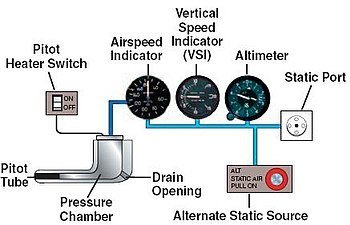Are Pitot-Static Inspections Required?
This is something that has come up many times in our environment. Especially with aircraft like the Diamond DA 20-C1 which is a VFR-only aircraft.
The main reason why we are all so confused is because of what we were first taught (Law of Primary). In training, we usually combine Pitot-Static & Transponder inspection together with the 24 calendar inspection. Does AV1ATE ring a bell?

A - Annual inspection
V - VOR every 30 days
1 - 100 Hours
A - Altimeter - Static System
T - Transponder
E - ELT
We normally add that the VOR is only required for IFR, but we never add it to the altimeter/pitot-static. So let’s add some clarity by actually reading the regulation.
FAR 91.411
§ 91.411 Altimeter system and altitude reporting equipment tests and inspections.
(a) No person may operate an airplane, or helicopter, in controlled airspace under IFR unless -
(1) Within the preceding 24 calendar months, each static pressure system, each altimeter instrument, and each automatic pressure altitude reporting system has been tested and inspected and found to comply with appendices E and F of part 43 of this chapter;
(2) Except for the use of system drain and alternate static pressure valves, following any opening and closing of the static pressure system, that system has been tested and inspected and found to comply with paragraph (a), appendix E, of part 43 of this chapter; and
(3) Following installation or maintenance on the automatic pressure altitude reporting system of the ATC transponder where data correspondence error could be introduced, the integrated system has been tested, inspected, and found to comply with paragraph (c), appendix E, of part 43 of this chapter.
(b) The tests required by paragraph (a) of this section must be conducted by -
(1) The manufacturer of the airplane, or helicopter, on which the tests and inspections are to be performed;
(2) A certificated repair station properly equipped to perform those functions and holding -
(i) An instrument rating, Class I;
(ii) A limited instrument rating appropriate to the make and model of appliance to be tested;
(iii) A limited rating appropriate to the test to be performed;
(iv) An airframe rating appropriate to the airplane, or helicopter, to be tested; or
(3) A certificated mechanic with an airframe rating (static pressure system tests and inspections only).
(c) Altimeter and altitude reporting equipment approved under Technical Standard Orders are considered to be tested and inspected as of the date of their manufacture.
(d) No person may operate an airplane, or helicopter, in controlled airspace under IFR at an altitude above the maximum altitude at which all altimeters and the automatic altitude reporting system of that airplane, or helicopter, have been tested.
[Doc. No. 18334, 54 FR 34308, Aug. 18, 1989, as amended by Amdt. 91-269, 66 FR 41116, Aug. 6, 2001; 72 FR 7739, Feb. 20, 2007]
We can clearly see that this regulation only applies to IFR flights, it is mentioned on the first line of the regulation. Some people will argue that because the transponder encoder is connected to the Pitot-Static system, then it makes it required, but this is not the case. They are two different regulations (91.413) and the encoder is tested on the transponder inspection.
We love to hear your feedback. Have you ran into this issue before? If so, share your experience with us in the comments below!

.png?width=178&height=50&name=Aviator%20Zone%20Academy%20(5).png)
Submit a Comment